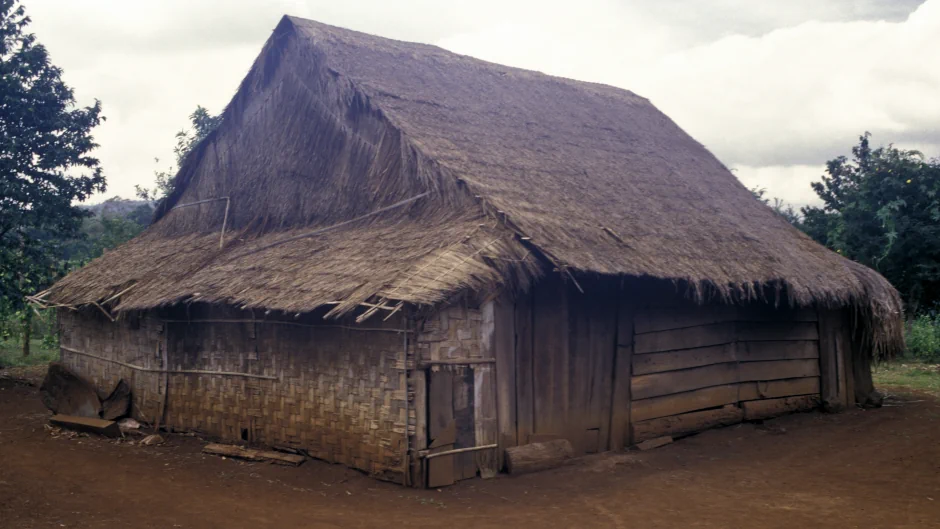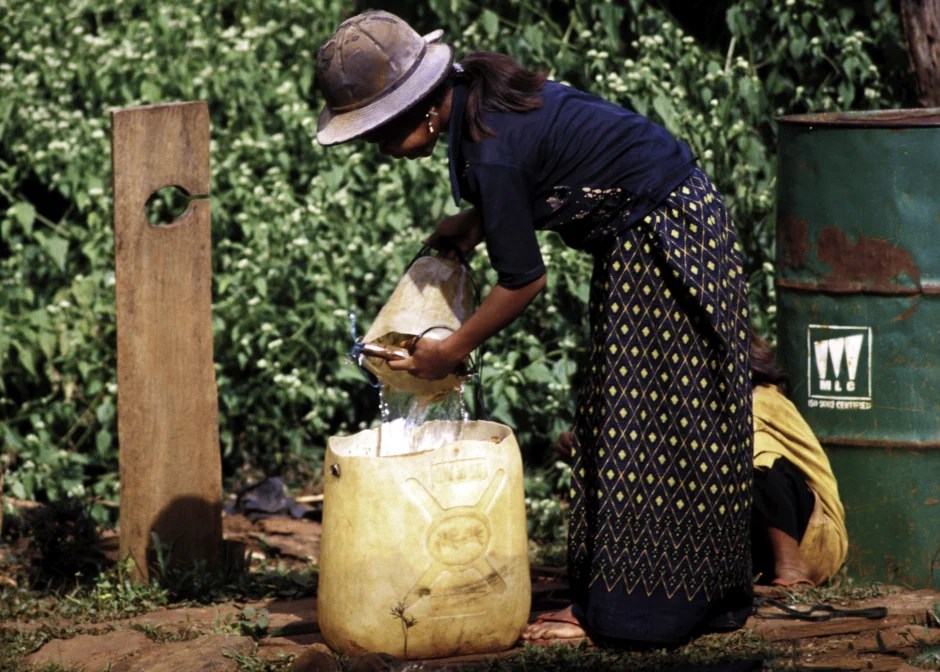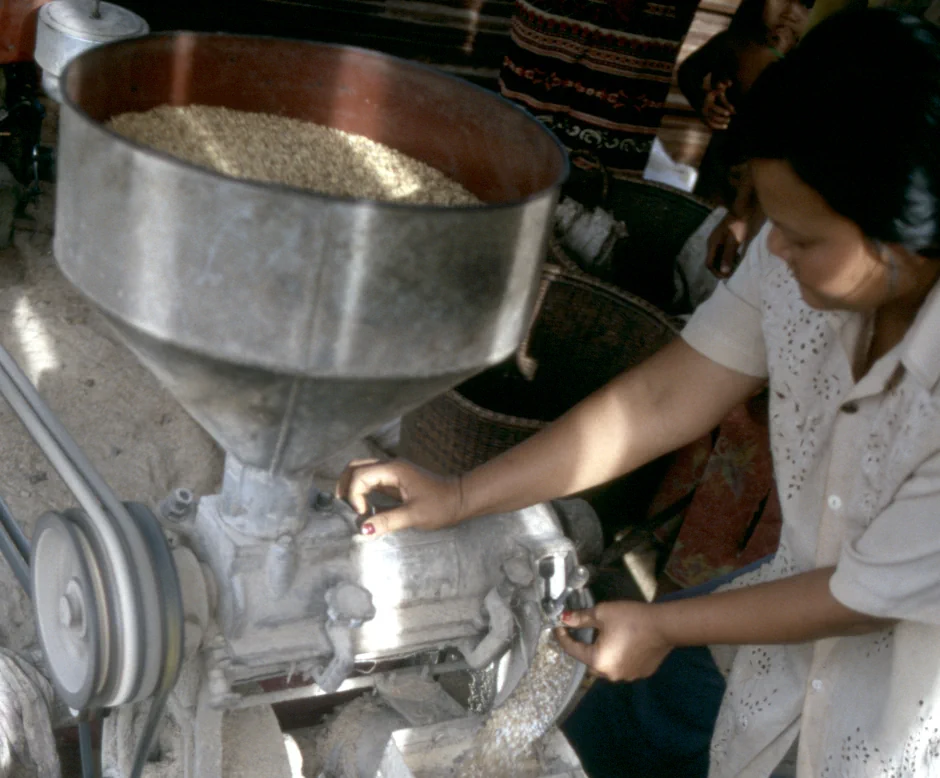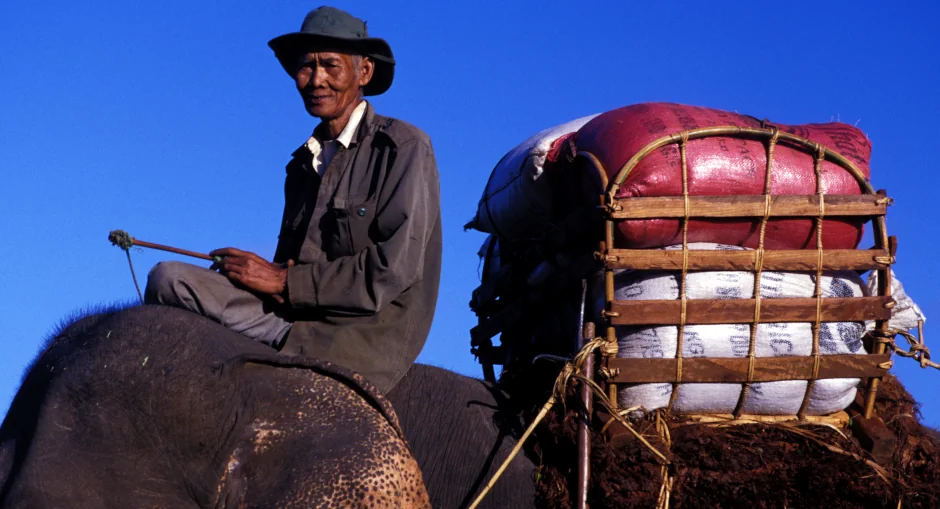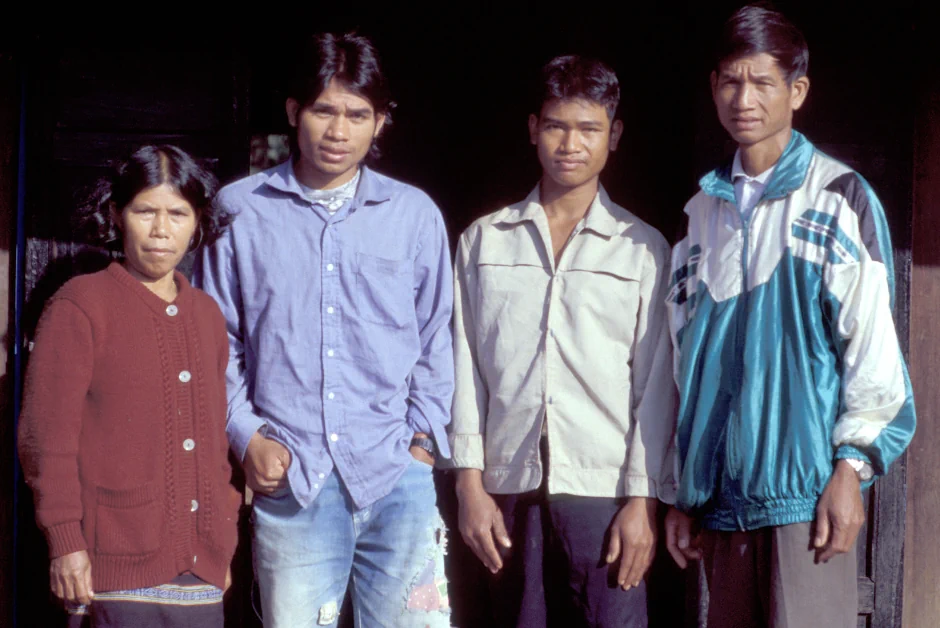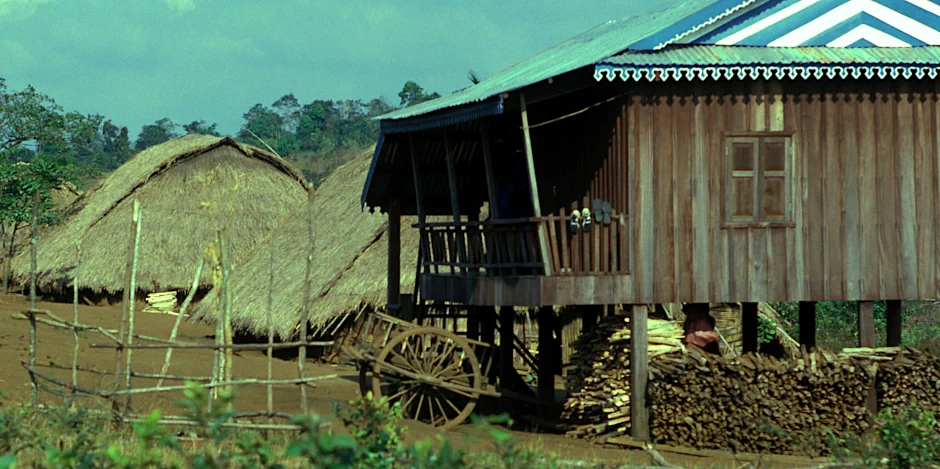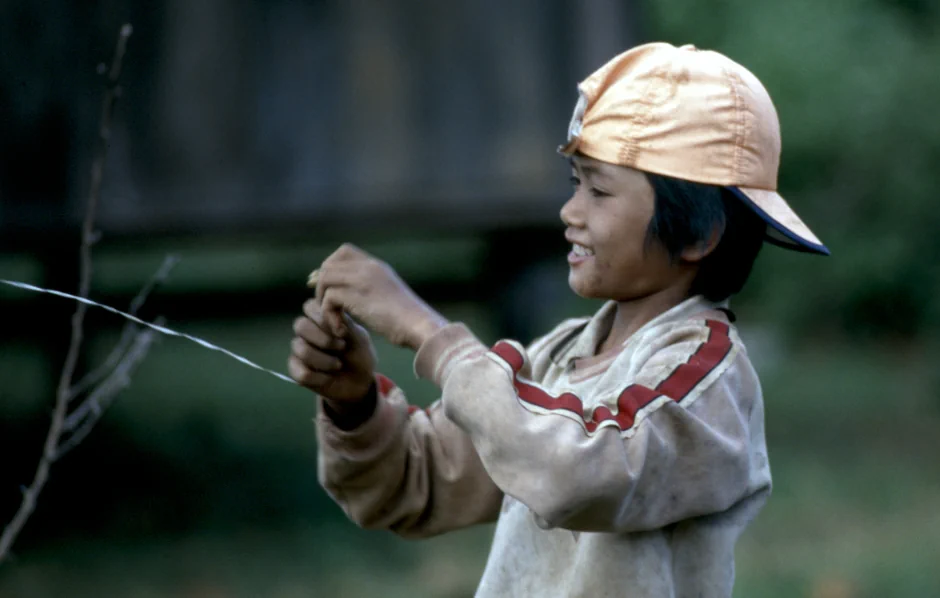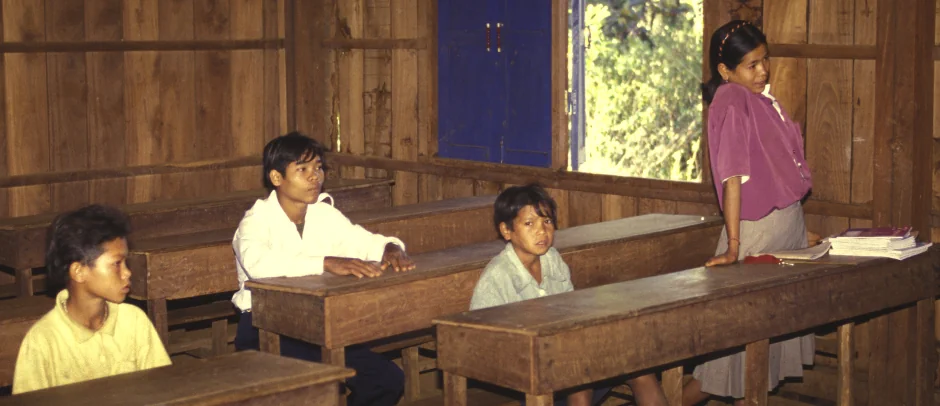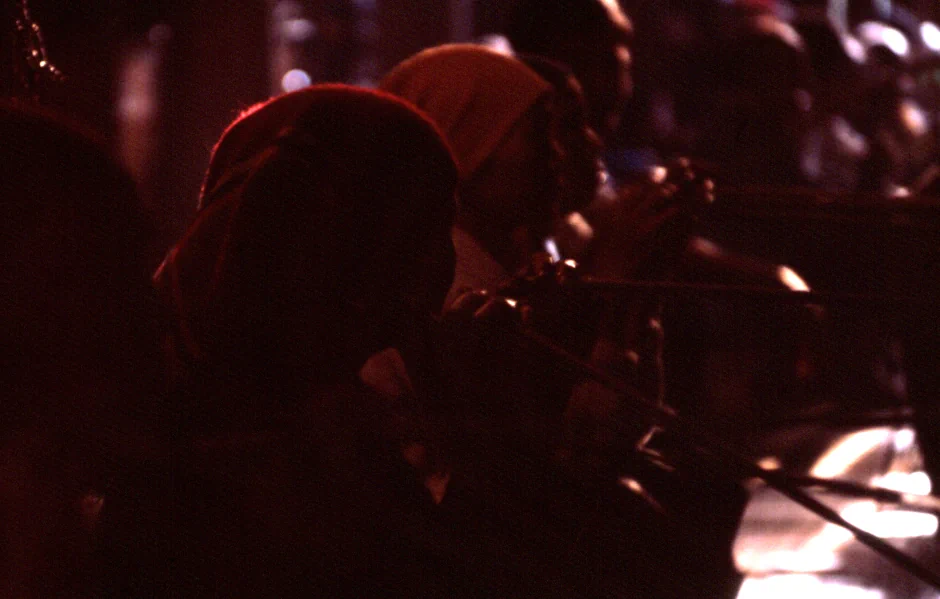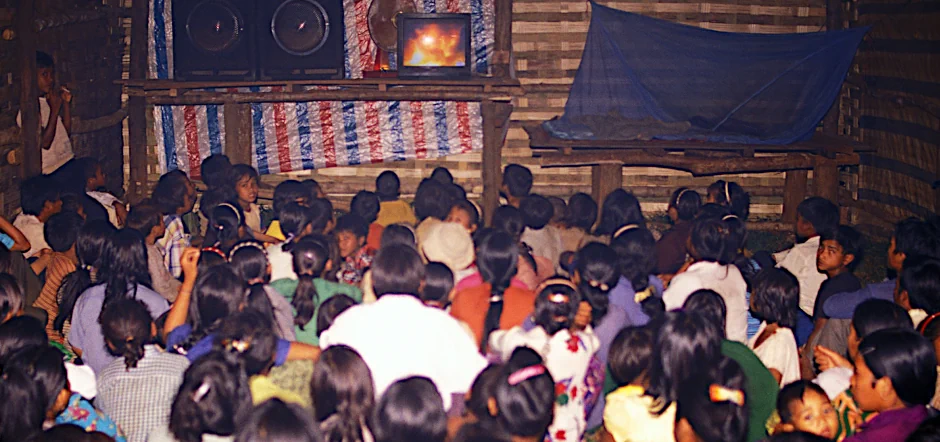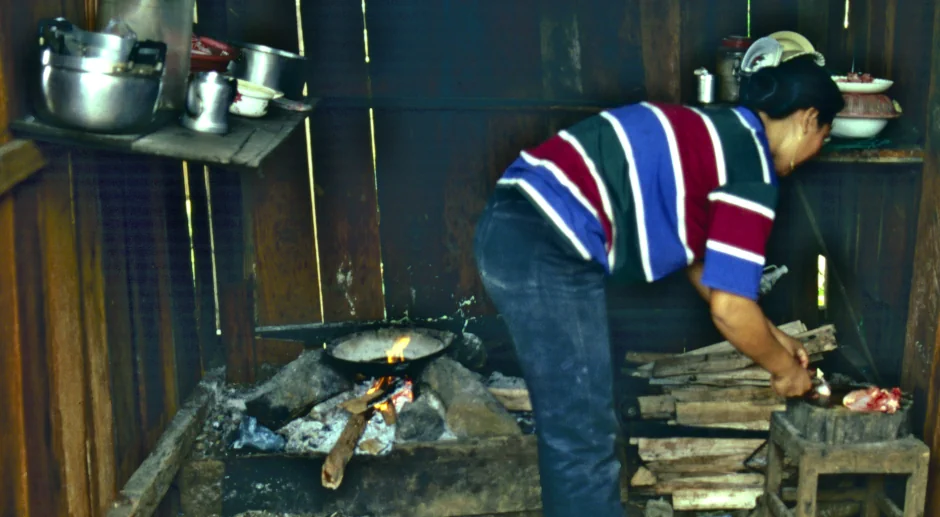The Indigenous Mnong People
Ethnonyms: Bu-dang, Budong, Chil Bu Nor, Ger, Kuyenh, M'nong, M'nong Bu-dang, Nong, Phnong, Pnong, P'nong, Prang, Preh, Rlam Countries inhabited: Cambodia, Vietnam, USA Language family: Austroasiatic Language branch: Mon-Khmer
When a child this small (in this photo she is an indigenous Mnong girl) performs hard, manual labor instead of attending school, we instinctively know that something is wrong.
Yet, when I visited an indigenous Mnong village not far away, I met a young Mnong woman who has benefited from education and is making a relatively prosperous income.
The indigenous Mnong people comprise around 100,000 people in Vietnam's Central Highlands, and around 20,000 in Cambodia's Mondolkiri Province. (A few Mnong families also live in Mondolkiri's northern provincial neighbor, Ratanakiri).
Once a part of the historically mighty Kingdom of Champa, which ruled this part of the world between the Second and Fifteenth Centuries, the Mnong today are the ruled instead of the ruler. This change has had psychological effects, since the ownership and ruling of land plays a strong role in Mnong cultural heritage.
Their rulers, over time, have included French colonialists (in both Vietnam and Cambodia), the US military (in Vietnam) and, most recently, the Khmer (in Cambodia) and the Viet (in Vietnam). Many Mnong villages have been displaced over the years by this turn in fortune, resulting in loss of land, livestock and other wealth.
Many Mnong were repatriated, in June, 2002, to the USA as political asylum seekers following protests at their treatment by their Viet rulers.
Although the two Mnong populations belong in the same ethnolinguistic classification, their dialects are not mutually understood.
Nor would they be mutually understood if they were written: Literacy is just beginning to reach the Mnong in Cambodia — a fascinating story told by our short documentary film, Indigenous Literacy in Cambodia, linked on this page. Mnong literacy in Vietnam is also relatively recent.
They live a subsistence, agrarian life in which they are self-sufficient in food — growing mainly dry rice, corn, sweet potatoes, watermelon and cassava — yet they sell little produce. Recently, though, the Mnong in Vietnam have cultivated coffee as a cash crop.
Traditionally semi-nomadic, slash-and-burn farmers, Vietnamese policy has made the Mnong sedentary in that country while, in Cambodia, UN- and NGO-funded programs have taught them more sustainable approaches to agriculture.
The Mnong are notable for many reasons. Whereas most indigenous peoples in this part of the world abandoned the domestication of elephants, the Mnong were successful at it. They also hunt elephants, another rare practice in Southeast Asia. (Cambodia is currently believed to have only a few hundred wild elephants left.) Snake is also commonly hunted but sold more often than eaten.
They are also the inventors of one of the world's oldest musical instruments — the lithophone. Made of stone, this instrument resembles a xylophone and is played only during special ceremonies. It is believed to be five thousand years old.
My own time spent with the Mnong was full of fascinating experiences and discoveries.
The first is an important cultural landmark for the Mnong people in Cambodia: The establishment of literacy. Until very recently, the Mnong in Cambodia were a pre-literate people. Literacy had been brought to their cousins in Vietnam by Christian missionaries some years earlier.
It took catastrophic geopolitical events, and the ability of one man to foreshadow the consequences of those events, to bring literacy to the Mnong in Cambodia.
In 1970, Mali and his wife, Troop, pictured above with their two children, realized that the unfolding, formative years of the then-fledgling Khmer Rouge in Cambodia posed a serious threat to them. Despite the danger of fleeing to Vietnam at that time (many people were trying to flee in the opposite direction), they left their village to take their chances.
It would be sixteen years before they returned to Cambodia.
During their time spent in Vietnam, they met an American Christian missionary who had learned the Mnong language, and who had developed a writing system for it, based on modern Vietnamese script. Through this missionary, Mali learned to read and write in his own language for the first time. When he returned to Cambodia in 1986, Mali brought with him not only Christianity, but also hymn books, prayer books and portions of the New Testament.
It was the first time the Mnong in Cambodia had seen their language written.
Mali spent the next few years teaching this new literacy in his village and in a few neighboring villages. Soon after his return, Cambodia became relatively more safe because of the political stability that came from the so-called democratic election of Hun Sen's Western- and UN-backed regime.
When news of his teaching found its way to Phnom Penh, the "unofficial" reaction was to discourage it, since the adoption of the Roman alphabet threatened the official national alphabet of Khmer. (The political reality was that a departure from the Khmer script might put the Mnong a step closer to independence from their Khmer rulers.)
Today, a cooperative effort has been undertaken involving NGOs, academic linguists and Christian missionaries to re-invent Mali's literacy program, with Cambodian government-approval and using the Khmer alphabet.
Although it will take a few generations, the outcome will be widespread literacy among the Cambodian Mnong for the first time in their history.
Three examples of the implications of this literacy stood out to me the first time I stayed in Mnong villages in Cambodia.
In November, 2001, the events of September 11 of that year were fresh on my mind. The Mnong I met were aware of what had happened from photographs they had seen in Khmer-language newspapers. When I spoke to them about their understanding and their opinion, they denied having any opinion, based on having no understanding of why the attacks had happened. That lack of understanding was due largely to their inability to read the Khmer language with any degree of true comprehension: The most salient observation to them was a realization that other parts of the world could be as dangerous as Cambodia.
Yet, as the young boy pictured above demonstrates, when images instead of words create their understanding, Mnong youth are able to relate to events they've seen portrayed in the US. Imagine how much greater would be their understanding of such a globally significant event if they could read about it in their first language.
The second example comes from my experience in a village school. Pictured above, the official enrollment at this school is twenty-five students. The attendance on the day of my visit — four students — is closer to the norm. Although many of the (ethnic Khmer) teachers in their villages can speak basic Mnong, they must revert to Khmer language and script when any part of the lesson requires writing.
Growing up pre-literate, these children are immediately lost when this happens. Any parent will appreciate the lack of motivation it creates in a child when that child is lost in the material. Imagine the increase in motivation when that same child sees the writing in Mnong.
The third example comes from Mnong cultural heritage. Like any indigenous people, the Mnong have a unique history that has been retold for countless generations. Because it has been passed on by word of mouth, much of that history has already been lost. My own efforts to locate Mnong people who could relate parts of their ancient folklore proved in vain.
Fortunately, in parallel with the Mnong literacy program in Cambodia, efforts are underway to search in far more villages than I had time to do, and write down what is still known of this history directly in the Mnong language.
A second fascinating experience comes from the time I was fortunate enough to be invited to a village wedding celebration. A wedding in a Mnong village is a much bigger event than any wedding in Western culture. The celebrations last for a minimum of three days, and they continue around the clock.
Everyone from the bride's and groom's village attends, and the bedlam of music and mass consumption of rice wine has to be heard and seen to be believed.
The Mnong are matrilineal, although only the children adopt the bride's clan name. The groom retains his own family name, since he is not considered to enter his wife's clan at marriage. Despite this matrilineage, though, village leaders and decision makers are still almost exclusively male.
Considering I had stumbled across this very personal celebration by chance, and I knew no-one from either village before I arrived, the Mnong wedding party and guests were as welcoming as anyone has ever been at weddings of my own friends and family.
My final fascinating experience, and an enduring personal memory, comes from an experience I had in a remote Mnong village in Cambodia. This village has seen few outsiders. I arrived there soon after the first diesel-powered electricity generator had been brought into the village.
One of the most popular uses of the generator was when someone had returned from the closest Khmer town with movies on videocassette (VHS).
One night, a movie was being shown in a large house that doubled as the village meeting hall. Although admission was only about 5 US cents, it amounts to a significant spending by an average family of 8 to 10 people. This, I learned, was why there were far more people outside, taking turns to peek through the door, than the handful that were inside.
I did not count how many people were outside, but when I offered to pay two US dollars to allow them all inside, the host jumped at the chance. I have never received such gratitude for giving such a small amount (to me) of money anywhere.
A footnote deserves mention here. Although I don't take artifacts from the villages I visit — except for handicrafts that are made for sale — I realized the likelihood, while conducting this research, that the Roman-alphabet Mnong hymnbooks that Mali brought into Cambodia would be lost when Khmer-alphabet literacy makes them obsolete. I took one of them (with permission) for the safekeeping of an important piece of Mnong cultural history. I have since passed it on to someone I trust for its continued safekeeping
Photography copyright © 1999 - 2026, Ray Waddington. All rights reserved. Text copyright © 1999 - 2026, The Peoples of the World Foundation. All rights reserved.

Waddington, R. (2002, revised edition 2024), The Indigenous Mnong People. The Peoples of the World Foundation. Retrieved January 7, 2026, from The Peoples of the World Foundation. <https://www.peoplesoftheworld.org/text?people=Mnong>
Web Links Indigenous Literacy in Cambodia (short film on YouTube). The animist Phnong hill tribe in Mondulkiri Province, Cambodia. Cultural Landscape of the Bunong People. Pnong: A Cambodian Tribal People. Books Maurice, A., (1996) Les MNong des Hauts-Plateaux (Center Vietnam). Paris: Edition L'Harmatan. Condominas, G., (1994) We Have Eaten the Forest: The Story of a Montagnard Village in the Central Highlands of Vietnam. New York: Kodansha International.


